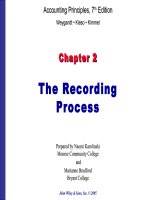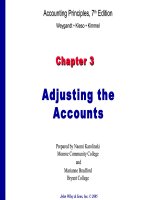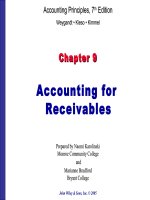Accounting principles 7th kieso kimel chapter 03
Bạn đang xem bản rút gọn của tài liệu. Xem và tải ngay bản đầy đủ của tài liệu tại đây (1.92 MB, 51 trang )
Accounting Principles, 7th Edition
Weygandt • Kieso • Kimmel
Chapter 3
Adjusting the
Accounts
Prepared by Naomi Karolinski
Monroe Community College
and
Marianne Bradford
Bryant College
John Wiley & Sons, Inc. © 2005
CHAPTER 3
ADJUSTING THE ACCOUNTS
After studying this chapter, you should be able to:
1 Explain the time period assumption
2 Explain the accrual basis of accounting
3 Explain why adjusting entries are needed
4 Identify the major types of adjusting entries
5 Prepare adjusting entries for prepayments
6 Prepare adjusting entries for accruals
7 Describe the nature and purpose of an
adjusted trial balance
TIME-PERIOD ASSUMPTION
STUDY OBJECTIVE 1
• The time period (or periodicity) assumption
– assumes the economic life of a business can be
divided into artificial time periods
• Accounting time periods
– generally month, a quarter, or a year
• Accounting time period of one year in length
– referred to as a fiscal year
ACCRUAL BASIS OF
ACCOUNTING
STUDY OBJECTIVE 2
• Revenue recognition and matching
principles
– Used under the accrual basis of accounting
• Cash basis accounting
– revenue is recorded when cash is received
– expenses are recorded when cash is paid
• GAAP requires accrual basis accounting
– cash basis often causes misleading financial
statements.
REVENUE RECOGNITION
PRINCIPLE
• Revenue recognition principle
– Revenue must be recognized in the
accounting period in which it is earned,
not just when money is exchanged.
– In a service business, revenue is earned at
the time the service is performed.
THE MATCHING
PRINCIPLE
• Expense recognition is the matching
principle.
• Efforts (expenses) must be matched with
accomplishments (revenues).
Revenues
earned
this
month
are offset
against....
Expenses
incurred in
earning
the
revenue
GAAP RELATIONSHIPS IN
REVENUE AND EXPENSE
RECOGNITION
Time-Period Assumption
Economic life of business
can be divided into
artificial time periods
Revenue-Recognition
Principle
Matching Principle
Revenue recognized in
the accounting period in
which it is earned
Expenses matched with revenues
in the same period when efforts
are expended to generate revenues
ADJUSTING
ENTRIES
STUDY OBJECTIVE 3
Adjusting entries are made in order for:
• revenues to be recorded in the period in which they
are earned
• expenses to be recognized in the period in which they
are incurred
ADJUSTING
ENTRIES
STUDY OBJECTIVE 4
Adjusting entries
– required each time financial statements
are prepared
•Adjusting entries are classified as
– Prepayments (prepaid expenses and
unearned revenues) OR
– Accruals (accrued revenues and
accrued expenses)
TYPES OF
ADJUSTING
ENTRIES
Prepayments
• Prepaid Expenses
Expenses paid in cash - recorded as assets before
used or consumed
•Unearned Revenues
Cash received - recorded as liabilities before
the revenue is earned
TYPES OF
ADJUSTING
ENTRIES
Accruals
• Accrued Revenues
revenues earned but not yet received in cash or
recorded
• Accrued Expenses
expenses incurred but not yet paid in cash or
recorded
TRIAL BALANCE
PIONEER ADVERTISING AGENCY
Trial Balance
October 31, 2005
Cash
Advertising Supplies
Prepaid Insurance
Office Equipment
Notes Payable
Accounts Payable
Unearned Revenue
C. R. Byrd, Capital
C. R. Byrd, Drawing
Service Revenue
Salaries Expense
Rent Expense
The Trial Balance
is the starting place
for adjusting
entries.
Debit
$ 15,200
2,500
600
5,000
Credit
$ 5,000
2,500
1,200
10,000
500
10,000
$
4,000
900
28,700 $ 28,700
PREPAYMENTS
STUDY OBJECTIVE 5
Prepayments
•The first category of adjusting entry is
prepayments.
•Required to record revenues earned and expenses
incurred
–Also ensures that assets and liabilities are not overstated
•The adjusting entry for prepayments:
–Increases an income statement account
–Decreases a balance sheet account
ADJUSTING ENTRIES FOR
PREPAYMENTS
Adjusting Entries
Prepaid Expenses
Asset
Expense
Unadjusted Credit
Balance
Adjusting
Entry (-)
Debit
Adjusting
Entry (+)
Unearned Revenues
Liability
Debit
Adjusting
Entry (-)
Unadjusted
Balance
Revenue
Credit
Adjusting
Entry (+)
PREPAID
EXPENSES
• Prepaid expenses
– expenses paid in cash and recorded as
assets before they are used or consumed
– Prepaid expenses expire with the passage
of time or through use and consumption
• An asset-expense account
relationship exists with prepaid
expenses
PREPAID
EXPENSES
• Prior to adjustment
– assets are overstated and expenses are
understated
• Adjusting entry
– debit expense account
– credit asset account
• Examples
– prepaid expenses include supplies,
insurance, and depreciation
ADJUSTING ENTRIES FOR
PREPAYMENTS
ADJUSTMENT
ADJUSTMENT
JOURNAL
JOURNALENTRY
ENTRY
POSTING
POSTING
SUPPLIES
October 31, an inventory count reveals that $1,000
of $2,500 of supplies are still on hand.
ADJUSTING ENTRIES FOR
PREPAYMENTS
INSURANCE
October 31, an analysis of the policy reveals
ADJUSTMENT
ADJUSTMENT
that $50 of insurance expires each month.
JOURNAL
JOURNALENTRY
ENTRY
POSTING
POSTING
Prepaid Insurance
Oct. 4
31
600 Oct. 31
550
10
50
DEPRECIATIO
N
Depreciation
• the allocation of the cost of an asset to expense
over its useful life in a rational and systematic
manner
• Equipment or a building
– viewed as a long-term prepayment of
services
– allocated in the same manner as other
prepaid expenses
DEPRECIATIO
N
•
Depreciation
is an estimate rather than a factual measurement of
the cost that has expired
–
•
Recording depreciation
–
–
Debit Depreciation Expense
Credit Accumulated Depreciation (contra asset)
Depreciation Expense
XXX
Accumulated Depreciation
XXX
DEPRECIATIO
N
• Balance Sheet
– Accumulated Depreciation is offset against the
asset account
• Book Value
– difference between the cost of any depreciable
asset and its related accumulated depreciation is
the book value of the asset
– not market value
ADJUSTING ENTRIES FOR PREPAYMENTS
DEPRECIATION
ADJUSTMENT
ADJUSTMENT
October 31, depreciation on the office equipment
is estimated to be $480 a year, or $40 per month.
JOURNAL
JOURNALENTRY
ENTRY
Date
Oct. 31
Account Titles and Explanation
Depreciation Expense
Accumulated Depreciation - Office Equipment
(To record monthly depreciation)
Debit Credit
40
40
POSTING
POSTING
Accumulated Depreciation Office Equipment
Oct. 31
40
Depreciation Expense
Oct. 31
40
UNEARNED
REVENUES
• Unearned revenues
– revenues received and recorded as
liabilities before they are earned
• Unearned revenues
– earned by rendering a service to a customer
• A liability-revenue account relationship exists with
unearned revenues
UNEARNED
REVENUES
• Prior to adjustment
– liabilities are overstated and revenues are
understated
• Adjusting entry
– debit to a liability account
– credit to a revenue account
• Examples
– rent, magazine subscriptions and customer
deposits for future services
ADJUSTING ENTRIES FOR
PREPAYMENTS UNEARNED
REVENUES
ADJUSTMENT
ADJUSTMENT
JOURNAL
JOURNALENTRY
ENTRY
POSTING
POSTING
October 31, analysis reveals that, of $1,200
in fees, $400 has been earned in October.









